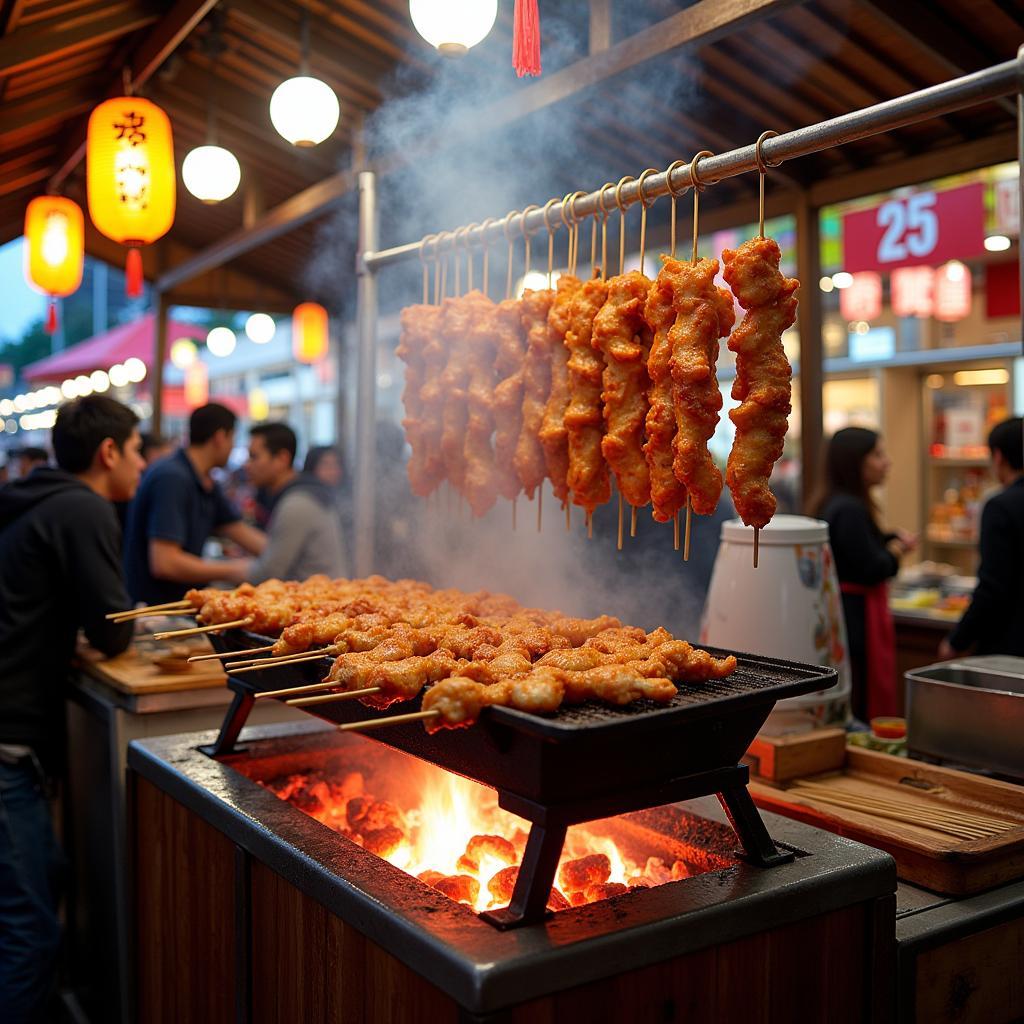Japanese Festival Foods are an integral part of the vibrant tapestry of Japanese culture, offering a tantalizing glimpse into the country’s rich culinary heritage. From savory yakitori to sweet dango, these treats are more than just snacks; they are a celebration of tradition, community, and the simple joys of life. This exploration of Japanese festival foods will tantalize your taste buds and inspire you to experience these culinary delights for yourself.
What are Japanese Festival Foods?
Japanese festivals, known as matsuri, are vibrant celebrations deeply rooted in tradition and community spirit. These festivals, held throughout the year, mark various occasions, from seasonal changes to religious observances. And what’s a festival without food? Japanese festival foods are a crucial element of these celebrations, offering a diverse array of flavors and textures that reflect the unique character of each event. These aren’t your everyday meals; they are special treats designed to be enjoyed amidst the festive atmosphere, adding another layer of joy and excitement to the occasion. These foods are often portable and easy to eat while strolling through the crowded festival grounds. They’re colorful, aromatic, and designed to be shared and enjoyed with friends and family. Whether you’re drawn to the savory aroma of grilled meats or the delicate sweetness of traditional sweets, Japanese festival foods offer something for everyone. Check out our guide on crafted food for more inspiration.
 Yakitori stand at a bustling Japanese festival
Yakitori stand at a bustling Japanese festival
Must-Try Japanese Festival Foods
Exploring the world of Japanese festival foods is a culinary adventure. From savory classics to unique regional specialties, there’s a delicious treat waiting to be discovered. Here are some must-try dishes that will tantalize your taste buds:
- Takoyaki: These bite-sized balls of savory goodness are filled with diced octopus, tempura scraps, pickled ginger, and green onions. They are cooked in special molded pans and then drizzled with a tangy sauce and sprinkled with bonito flakes and aonori seaweed.
- Yakitori: Skewers of grilled chicken, marinated in a sweet and savory sauce, yakitori is a festival staple. The smoky aroma and tender, juicy meat make it a crowd favorite.
- Okonomiyaki: Often referred to as a “Japanese savory pancake,” okonomiyaki is a grilled dish made with a batter of flour, yam, and cabbage. It can be customized with various toppings, such as meat, seafood, vegetables, and cheese.
- Dango: These chewy rice dumplings are served on skewers and come in various flavors, from sweet soy sauce to red bean paste. Their soft texture and delicate sweetness make them a perfect dessert.
Experiencing Japanese Festival Foods
Japanese festival foods are best enjoyed amidst the vibrant energy of a matsuri. The lively atmosphere, the traditional music, and the sense of community create a unique backdrop for savoring these culinary delights. Imagine yourself strolling through the festival grounds, surrounded by colorful lanterns and the cheerful chatter of fellow festival-goers, as you bite into a freshly grilled yakitori skewer or savor the sweet taste of a dango. If you’re interested in exploring more unique food experiences, check out hotei mono food.
What’s the most popular Japanese festival food?
While personal preferences vary, takoyaki and yakitori consistently rank among the most popular Japanese festival foods, loved for their savory flavors and convenient portability.
Are Japanese festival foods expensive?
Generally, Japanese festival foods are reasonably priced, making them accessible to everyone attending the festivities. You can often find a delicious snack for just a few hundred yen.
 Children enjoying dango at a Japanese festival
Children enjoying dango at a Japanese festival
The Cultural Significance of Japanese Festival Foods
Japanese festival foods are more than just snacks; they are a tangible link to the country’s rich culinary traditions. Many of these dishes have been passed down through generations, carrying with them stories and cultural significance. They are a symbol of community, celebration, and the simple joys of life. Sharing these foods with friends and family is an integral part of the matsuri experience, fostering a sense of togetherness and shared cultural identity. For food enthusiasts, exploring food t-shirts can be a fun way to express their passion.
Conclusion
Japanese festival foods offer a delightful window into the heart of Japanese culture. From the savory delights of takoyaki to the sweet simplicity of dango, these treats are a testament to the country’s rich culinary heritage. So, the next time you find yourself at a Japanese festival, be sure to indulge in these culinary delights and experience the true spirit of matsuri. If you’re looking for more food options, consider exploring giant prepared foods or even trying something unique like joy cat food for your feline friend.
FAQ
- What are some common ingredients in Japanese festival foods? Common ingredients include rice, noodles, seafood, chicken, and various vegetables.
- Are there vegetarian options available at Japanese festivals? Yes, many festivals offer vegetarian options, such as vegetable tempura and vegetarian okonomiyaki.
- What is the best time of year to experience Japanese festivals? Festivals are held throughout the year, but spring and summer are particularly popular seasons.
- What should I wear to a Japanese festival? Casual clothing is acceptable, but wearing a yukata (traditional summer kimono) can enhance the experience.
- Are Japanese festivals family-friendly? Yes, most Japanese festivals are very family-friendly and offer activities and entertainment for all ages.
- What are some etiquette tips for attending a Japanese festival? Be mindful of others, dispose of your trash properly, and be respectful of the traditions and customs.
- How can I find information about upcoming Japanese festivals? Local tourist information centers and websites often provide details about festival schedules and locations.
Need support? Contact us at Phone Number: 02437655121, Email: minacones@gmail.com Or visit us at: 3PGH+8R9, ĐT70A, thôn Trung, Bắc Từ Liêm, Hà Nội, Việt Nam. We have a 24/7 customer service team.